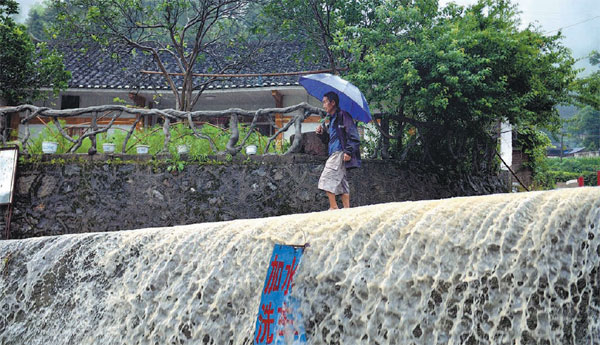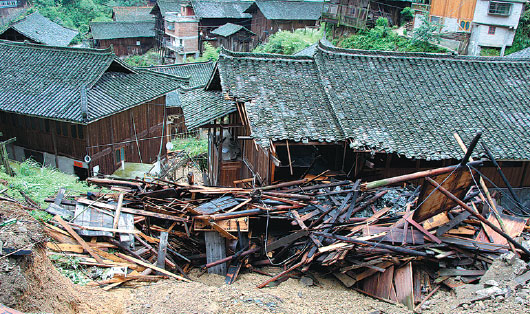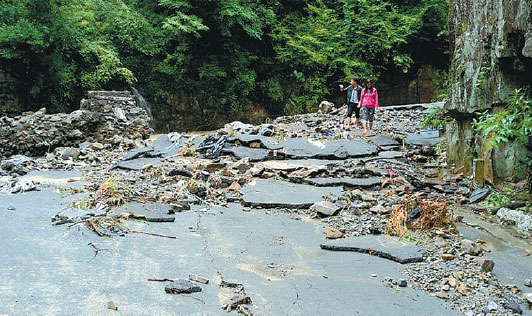Early warnings help flood-hit rural residents
Updated: 2015-06-15 07:44
By XuWei(China Daily)
|
|||||||||||
Measures are being taken to reduce the number of casualties and the damage caused by flooding of small and medium-sized rivers during the rainy season in southern China, as Xu Wei reports from Guiding, Guizhou province.
Zhao Zegao never dreamed the rocky creek that flows near his home could pose a threat to his home and farmland. At least, not until the night of May 19 when his village was hit by what Zhao described as "the largest downpour I have ever seen in my life".
The 59-year-old resident of Nongzhuang village in Dingdong county, Guizhou province, was attending a dinner when a three-hour storm brought 146.2 millimeters of rain and caused the babbling brook to become a raging torrent that burst its banks, flooding the village within an hour.
"The water level was rising with every minute, and the village officials told us to evacuate before it was too late," Zhao said, recalling how his family ran to take cover in a nearby mountain tunnel.
The warning saved Zhao and his family. The water quickly swallowed homes and farmland, and when Zhao returned home the following morning he found that his house was coated in mud, his crops had been destroyed and drowned livestock were floating in the muddy water.
Zhao and his fellow villagers are now trying to rebuild their lives and farms, but this was not an isolated incident. By May 26, floods caused by torrential rain had killed 43 people and affected a further 7.8 million people in southern China. However, the places worst affected weren't situated on the banks of major waterways - most of the worst flooding occurred in streams and medium-sized rivers, according to the State Flood Control and Drought Relief Headquarters.
Every year, flooded streams and medium-sized rivers account for 70 to 80 percent of flood-related casualties nationwide, the authority said. Last year, more than 300 people died as a result of flooding of smaller streams and rivers, accounting for 61 percent of the 485 people killed in flooding across the country.
Zhang Jiatuan, a spokesman for the State Flood Control Headquarters, said controlling streams and medium-sized rivers would be a key task as authorities strive to prevent the number of casualties from rising.
"We have effectively raised the flood-prevention standards of large rivers in the past two or three decades. The vulnerable areas are now the thousands of small and medium-sized rivers where effective flood-prevention measures haven't been put in place," he said.
A 2013 general survey conducted by the Ministry of Water Resources showed that more than 9,200 rivers have basins that cover at least 200 square kilometers, and they pose major flood risks.
The hazard is so widespread in southern China that every ravine and creek could pose a risk in the event of prolonged downpours, according to Wei Shanzhong, deputy director of the Changjiang Water Resources Commission.
Wei said early warnings have so far proved to be the best way of preventing casualties because residents have plenty of time to evacuate their homes and retreat to higher ground. "We send out the early warning, and then the village heads and grassroots officials are responsible for passing it on to residents and ensuring their safety," he said.
This year, the risk of flooding has been rising, and the meteorological authorities have predicted that the middle reaches of the Yangtze River basin could receive 20 percent more rainfall than usual. Meanwhile, the National Flood Prevention Headquarters is expecting a scenario similar to that in 2010 when 437 rivers flooded, resulting in a death toll of 3,222, with another 1,003 people still unaccounted for.
To make matters worse, El Nino - a warming of the surface temperature in the Pacific Ocean that affects wind patterns - is also expected to bring more rainfall to the south of the country, thereby increasing the chances of small rivers overflowing.
Forecasting difficulties
Hundreds of people lost their lives as a result of flooding on small and medium-sized rivers between 2009 and 2014, according to the State Flood Control and Drought Relief Headquarters.
Unlike large waterways, where it can take several days for a major flood to take shape, forecasting floods and their effects on small rivers is a very difficult process.
Zhou Xinchun, a flood forecaster with the water resources commission, said only one or two hours of continuous rain can result in small rivers breaking their banks without warning. "The whole process is so short that it barely leaves us enough time to make a prediction," he said.
In addition, it's also extremely difficult to accurately predict the exact amount of rainfall an area will receive over a short period of time, which results in different flood scenarios depending on the geography of the affected area, he added.
In response, central government departments, including the Ministry of Water Resources and the Ministry of Finance, have rolled out a number of policy documents and investment plans to support flood-prevention measures on small and medium-sized rivers across the country.
Under an action plan initiated by the ministries in 2013, more than 130 billion yuan ($21 billion) will be invested in flood-prevention projects on small and medium-sized rivers and reservoirs by the end of the year. The ministries estimate that the program will alleviate the flood risks posed by more than 4,006 rivers nationwide.
However, the work is progressing slowly. By September, only 1,289 of the proposed 5,974 programs had been completed, and 48 percent of the programs had yet to be started. Confusion over sources of funding is one of the major stumbling blocks to completion, according to Chen Min, director of the Changjiang Water Resources Commission.
"The financing of projects has proved difficult because local governments have very limited financial capacities, but central government finance isn't applicable for the funding of such projects because they only benefit residents of small areas," Chen said.
Wei, from the Changjiang Water Resources Commission, said more must be done to establish effective early warning systems that will allow villagers time to evacuate their properties, and thereby reduce the number of flood-related casualties.
"It's important to establish an emergency response plan in each village, so warnings can be sent out and villagers know exactly what to do in the event of a flood," he said.
Elderly most at risk
Another challenge lies in the country's rapid urbanization, which has seen young rural residents move to the towns and cities in search of work and has resulted in many elderly village dwellers being left without family care.
"Elderly people and children are the groups that require the most help in times of flooding," Wei said. The outflow of young people has also resulted in a shortage of rescue teams in rural areas, he said.
According to the Ministry of Civil Affairs, nearly 50 million elderly rural residents face problems as a result of their children leaving home.
The problem hasn't gone unnoticed in Nongzhuang village, where many members of the younger generation have moved away. Zhao's son and daughter are typical, having both moved to cities in the east of the country in search of work and higher living standards.
"The flood has made the old waterways even more dangerous because the old river banks have been destroyed. I don't know what will happen if another flood strikes," Zhao said.
Yang Xianzhong, head of Xingxi, a village in Yanshan township in Guiding, said that every time the local river floods, officials and volunteers have to check every household to ensure that no one has been left behind.
"Loudspeakers, text messages and even gongs - we've tried all possible measures to warn residents. But some elderly people don't use cellphones, and are unable to hear the messages broadcast over the loudspeakers, either," he said.
The river that runs in front of the mountain village floods two or three times every year. On June 8, the village saw the biggest flood in its history when the river burst its banks after just three hours of continuous rain. The water rose more than 1.5 meters above the usual level, and although there were no reports of deaths or injuries, the deluge caused immense damage to farmland and crops.
Yang said the village is applying for national funds to raise the defenses to a level that would resist a "once-in-20-years flood", but admitted that in a worst-case scenario, the village would be defenseless: "This is the best thing we can do right now. If we come across floods even bigger than that, we will just have to make way for nature."
Yang Zhaohui, chief engineer with the Guizhou Province Department of Water Resources, said it simply isn't possible to improve the flood-prevention measures on every small river in the province.
"We have to measure our input and output because we only have limited financial resources. It's not possible for us to improve the defenses of every township to a level where every place is able to resist the impact of a 'once-in-a-100-years' flood. Even if we did, what if a '200-year flood' struck later?" he said.
"At present, our best option is to warn the residents in time and save their lives. Loss of property can always be remedied, but loss of life cannot."
Contact the writer at xuwei@chinadaily.com.cn
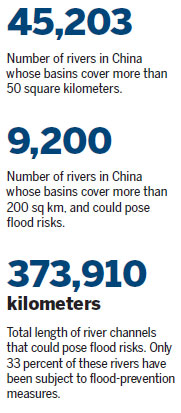
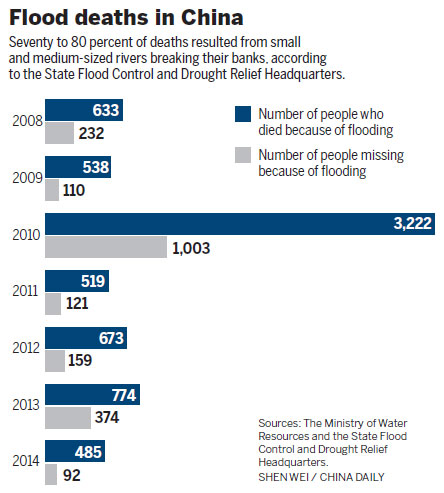
|
A villager walks in the rain in Yuqing county, Guizhou province. Heavy downpours caused floods that submerged roads and damaged houses in the county on June 10. He Chunyu / for China Daily |
|
A house destroyed by flooding in Leishan county, Guizhou. The county was hit by heavy rain on June 8. Provided to China Daily |
|
Villagers walk on a section of a provincial road damaged by flooding in Jianhe county, Guizhou. Chen Peiliang / for China Daily |
(China Daily 06/15/2015 page6)
Today's Top News
Zhou Yongkang sentenced to life in prison
China committed to addressing climate change
Moscow gravely concerned over US bio-lab deployed near Russian border
Murdoch's sons to become CEO, co-chair at 21st Century Fox
Zhou Yongkang sentenced to life in prison
Kiev announces new round of peace talks on Ukraine crisis
Greece, EU powers agree to step up debt talks as crunch looms
EU sanctions hamper Italian-Russian commercial ties: Putin
Hot Topics
Lunar probe , China growth forecasts, Emission rules get tougher, China seen through 'colored lens', International board,
Editor's Picks

|

|

|

|

|

|
